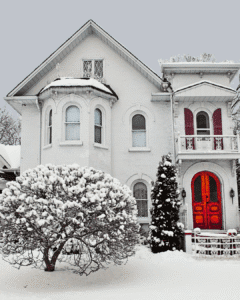
13 Tips to Winterize Your Home
Winterizing your home may feel like a chore but if a harsh winter is on its way, you’ll live more comfortably. Here are 13 tips on how homeowners can prepare for the coming winter months.
1. Reverse your Ceiling Fans
By reversing your ceiling fan direction to clockwise in the winter, it helps push that warm air down and cool air upward. Run it at the lowest speed to help distribute heat evenly throughout the room and prevents a drafty “wind chill”. If you change your ceiling fan clockwise when the temperature drops, you can help reduce draftiness and your utility bill.
2. Seal doors, Windows and Insulate
Don’t wait until the weather gets too cold to seal doors and windows from the outside. The goal is to prevent cold air from entering your home and also prevent heat from escaping. Run your hand along the edges to feel for any cold-air drafts because even the smallest crack can bring down your home’s energy efficiency. Caulking indoors seals best in warmer weather so caulking indoors can be done anytime. You can also use weatherstripping and draft stoppers to winterize your home. For extra insulation on windows, bubble wrap works great and keeps the light shining through.
3. Add Insulation to your Garage & Attic
Adding insulation in the attic is an effective way to keep your home warm and energy-efficient. If your home is a bit aged and gets unbearably cold during the winter, doing so may be one of the best ways to winterize your property.
If you are adding more insulation over top an existing layer, avoid using the vapour barrier type and make sure the attic itself is vented properly so moisture could build up and start mould growth. Be sure the attic is vented properly as well. If you’re unsure of the insulation to use, visit your local home store and let them know what kind of insulation you already have up.
Insulating your garage, especially if it’s attached, will warm adjacent rooms and save you money on your heating bills. Consider spray foam, as the R rating is much higher.
4. Service Your Furnace
When you first turn on your furnace, it will leave a smell, but if the odour persists, turn it off and call a professional for service. Once your inspection and cleaning is complete, purchase a sufficient amount of furnace filters for the season and in case stock runs low. A grimy filter will reduce your furnace’s efficiency by restricting airflow. If you are considering replacing your older furnace with a more energy efficient one, it will heat your home better and save you money in the long run.
5. Inspect your Chimney and Fireplace
Having your chimney inspected will identify any cracks or structural deterioration that can allow cold air into your home. While you’re at it, they will look for any animals making a home there. Be sure to service your chimney before the cold weather starts and animals make their home there.
If you have a chimney, servicing it will help you winterize your house. Not only will doing so help remove any build-up of creosote (a flammable by-product of burning wood), but it will also improve the flow of air and allow the chimney to operate more effectively. When servicing your chimney, be sure your fireplace works and provides a secondary reliable heat source for your home.
6. Clean your Eavestrough and Gutters
Making sure your eavestrough and gutters are clear will keep rain and melting snow flowing. This will prevent dangerous icicles from forming and falling, as well as pools of water to turn to ice. Be sure to remove fall leaves and debris before the weather gets too cold.
7. Inspect your Roof for Leaks
A roof inspection is crucial to winterizing your home. Any structural leaks can cause water to accumulate and freeze in many parts of your home, causing expansion and structural damage.
8. Drain and insulate Exposed Water Pipes and Outdoor Spigots
Be sure to remove your hoses and drain your water pipes and faucets to prevent pipes from bursting in the cold. Wrap outdoor water pipes with insulation and know where the water shut-off is in case of emergency. Also drain your air conditioner and close its shut-off valve, if it has one. As well, blow your water irrigation system with clean air to remove all water so they don’t freeze, and crack the pipes. Be sure to know where the water shut-off is to prevent your basement from flooding if pipes burst.
9. Trim Trees to Winterize Your Home
Hire an arborist or trim trees and bushes yourself for optimum growth in the spring. Also, overhanging tree branches could break off and fall on your home if covered by heavy snow.
10. Check your Snowblower
Make sure your snowblower is working and you have enough fuel on hand for our first snowstorm. Gasoline doesn’t freeze so be sure to store the fuel in a separate outdoor cubby away from your house.
11. Keep D-icer and sand On-hand
Having d-icer and sand on hand will help prevent hazards like slips and falls and d-icers for locks that are frozen won’t leave you out in the cold.
12. Build a Car Winter Survival Kit
Having a winter survival kit handy will lessen the stress during an outdoor emergency.
Be sure to pack these items.
Flashlight
Batteries
Candles
Matches
Lighters
Blankets
Snacks & bottled water
A first-aid kit
ice scraper, shovel,
jumper cables.
tire inflator and repair kit
13. Stock Up on Food and Water
Having stock of your favourite food and snacks doesn’t hurt
Once you have winterized your home, all that’s left is you cozying up to a good book and staying warm all winter. If you are considering moving this winter, allow me to conduct a complimentary home evaluation.
